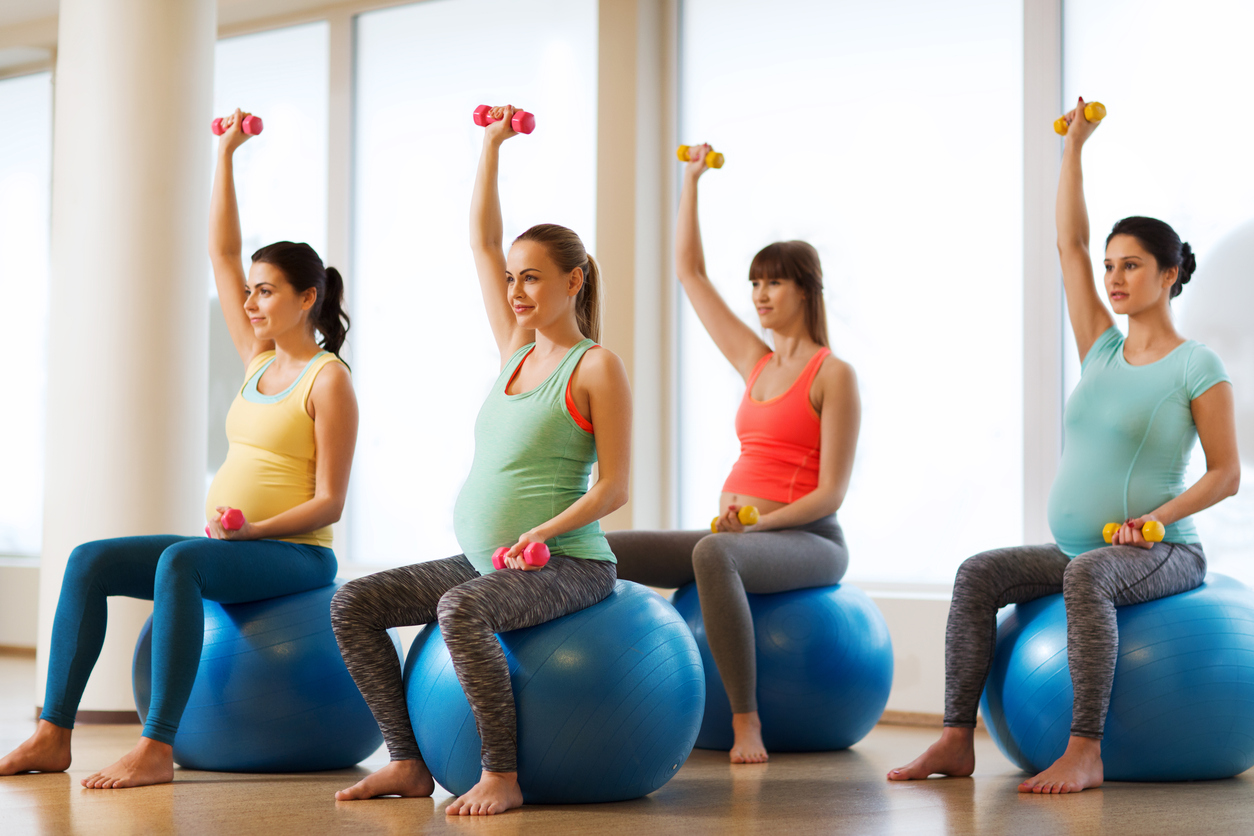

Featured
Can You Exercise When You’re Pregnant
Published: September 26, 2023
Stay healthy and active during your pregnancy with our featured exercise tips. Find out if you can exercise safely while expecting and get expert advice.
Introduction
Being pregnant is a beautiful and transformative experience, and it’s natural to have questions about what activities are safe and beneficial during this special time. One common question that arises is whether it is safe to exercise while pregnant. The answer is a resounding yes! In fact, maintaining an active lifestyle during pregnancy can have numerous benefits for both the mother and the baby. However, it is crucial to approach exercise with caution and to make certain considerations to ensure the well-being of both mom and baby.
Pregnancy is a remarkable journey that encompasses physical and emotional changes. Regular exercise can provide a host of advantages during this time, including increased energy levels, improved mood, reduced pregnancy discomfort, and enhanced overall fitness. Engaging in appropriate physical activity can also help to prepare the body for the demands of labor and delivery.
Before embarking on an exercise routine during pregnancy, it is important to consult with your healthcare provider to ensure that it is safe for you and your baby. They can offer personalized advice based on your individual circumstances, including any existing medical conditions or complications that may require modifications to your exercise routine.
In this article, we will explore the benefits of exercise during pregnancy, provide guidelines for exercising while pregnant, discuss safe exercises for pregnant women, highlight exercises to avoid, suggest modifications and adaptations for pregnancy, and outline the precautions and potential risks associated with exercising during this time. By the end, you will have a comprehensive understanding of how to approach exercising while pregnant and be better prepared to embark on a safe and effective exercise routine that promotes both your health and the health of your baby.
Benefits of Exercise During Pregnancy
Regular exercise during pregnancy offers a wide range of benefits for both the expectant mother and her developing baby. Incorporating physical activity into your routine can have positive effects on your physical, mental, and emotional well-being. Let’s explore some of the key benefits of exercising during pregnancy:
1. Increased energy levels: Pregnancy often comes with fatigue and decreased energy levels. However, engaging in regular exercise can help boost your energy levels and combat feelings of sluggishness. Exercise stimulates the production of endorphins, the feel-good hormones, providing you with a natural energy boost.
2. Improved mood: Pregnancy hormones can sometimes lead to mood swings and heightened emotions. Exercise is a fantastic mood booster, as it releases endorphins that promote a sense of happiness and well-being. Taking some time to engage in physical activity can help alleviate stress, anxiety, and depression, leaving you feeling more relaxed and content.
3. Reduced pregnancy discomfort: Pregnancy can bring about physical discomforts such as backaches, swollen ankles, and constipation. Regular exercise can help alleviate these discomforts by improving circulation, strengthening muscles, and increasing flexibility. For example, exercises like prenatal yoga and gentle stretching can help relieve back pain and improve overall flexibility.
4. Enhanced overall fitness: Maintaining a certain level of fitness during pregnancy can have long-term benefits for your health. Regular exercise can help improve cardiovascular stamina, muscular strength, and endurance. Additionally, it can help prevent excessive weight gain, reduce the risk of gestational diabetes and preeclampsia, and ease the postpartum recovery process.
5. Improved sleep: Many pregnant women struggle with sleep disruptions. Engaging in regular physical activity can promote better sleep quality, as it helps to regulate sleep patterns and reduce the likelihood of experiencing insomnia or restless nights.
6. Preparation for labor and delivery: Labor and delivery require stamina, strength, and endurance. Regular exercise during pregnancy can help prepare your body for the physical demands of labor by strengthening your pelvic muscles, improving your breathing techniques, and enhancing your overall endurance.
7. Bonding with your baby: Exercise doesn’t have to be a solitary activity! Pregnancy workouts can be an opportunity to bond with your baby. Many exercises, such as prenatal swimming or gentle dancing, allow you to connect with your baby while staying active and healthy.
It’s important to remember that every pregnancy is unique, and what works for one person may not work for another. It is crucial to listen to your body, make modifications as needed, and consult with your healthcare provider to ensure that you are engaging in safe and appropriate exercise routines throughout your pregnancy journey.
Considerations and Guidelines for Exercising While Pregnant
When it comes to exercising during pregnancy, it is important to prioritize both the safety of you and your baby. While staying active is beneficial, there are some considerations and guidelines to keep in mind to ensure a safe and effective workout routine:
1. Consult with your healthcare provider: Before starting or continuing an exercise routine during pregnancy, it is essential to consult with your healthcare provider. They can provide personalized advice based on your medical history and any complications or conditions you may have. Your healthcare provider can help determine if any adjustments need to be made to ensure the safety of both you and your baby.
2. Choose low-impact activities: During pregnancy, it is generally recommended to opt for low-impact exercises that are gentle on the joints and minimize the risk of injury. Activities such as walking, swimming, stationary cycling, prenatal yoga, and modified strength training exercises can be excellent choices.
3. Warm up and cool down: Prior to starting any exercise, it is important to warm up your muscles to reduce the risk of injury. Incorporate a few minutes of gentle stretching or walking to prepare your body for the workout. Similarly, remember to cool down and stretch after your workout to help prevent muscle soreness and aid in recovery.
4. Listen to your body: Pregnancy is a time of significant physical changes, so it’s important to pay attention to your body’s signals. If something doesn’t feel right or you experience dizziness, shortness of breath, vaginal bleeding, or contractions, stop exercising immediately and seek medical attention.
5. Stay hydrated: Pregnancy increases the body’s need for hydration, especially during exercise. Drink plenty of water before, during, and after your workout to ensure you are properly hydrated. Avoid overheating by exercising in a well-ventilated area or using fans if needed.
6. Wear comfortable clothing and supportive footwear: Choose loose-fitting, breathable clothing that allows for freedom of movement and helps regulate your body temperature. Invest in good-quality, supportive footwear to provide stability and reduce the risk of falls or injuries.
7. Modify as needed: As your pregnancy progresses, you may need to modify certain exercises to accommodate your growing belly and changing body. Listen to your body and make adjustments as necessary. For example, switch from high-impact exercises to low-impact alternatives or use supportive props during yoga poses.
8. Practice proper posture: As your body changes during pregnancy, it’s important to maintain good posture to avoid strain on your back and joints. Engage your core muscles, stand tall, and avoid slouching or arching your back during exercise.
Remember, the overall goal of exercise during pregnancy is to maintain a healthy lifestyle, not to push yourself to extremes. The focus should be on gentle movement, maintaining fitness, and promoting overall well-being for both you and your baby. Always prioritize safety and listen to your body’s needs to ensure a positive exercise experience throughout your pregnancy journey.
Safe Exercises for Pregnant Women
Staying active during pregnancy is important for maintaining overall health and well-being. Here are some safe exercises that are generally suitable for pregnant women:
1. Walking: Walking is a low-impact exercise that can be enjoyed throughout pregnancy. It provides cardiovascular benefits, promotes circulation, and helps maintain a healthy weight. Aim for at least 30 minutes of brisk walking most days of the week.
2. Swimming: Swimming and water aerobics are excellent choices during pregnancy. The water provides buoyancy, which reduces the strain on your joints and helps relieve the extra weight of your growing belly. Swimming also provides a full-body workout and can help alleviate swelling and discomfort.
3. Prenatal yoga: Prenatal yoga is specifically designed for pregnant women and focuses on gentle stretching, relaxation, and breathing techniques. It helps improve flexibility, strength, and balance, while also promoting relaxation and stress reduction. Look for specialized prenatal yoga classes or online resources led by certified instructors.
4. Stationary cycling: Cycling on a stationary bike is a low-impact exercise that provides cardiovascular benefits without putting strain on the joints. Adjust the intensity and resistance according to your comfort level, and ensure proper bike setup to maintain good posture throughout the workout.
5. Modified strength training: Strength training exercises can help maintain muscle tone and strength during pregnancy. Opt for exercises that target major muscle groups and utilize lighter weights or resistance bands. Focus on proper form and avoid exercises that put excessive strain on your joints or abdomen.
6. Prenatal Pilates: Prenatal Pilates focuses on gentle, controlled movements that help strengthen the core, improve posture, and enhance flexibility. It can also aid in maintaining pelvic floor strength, which is beneficial for labor and postpartum recovery. Look for prenatal Pilates classes or modify traditional Pilates exercises as needed for pregnancy.
7. Low-impact aerobics: Low-impact aerobic exercises, such as step aerobics or dance-based workouts specifically designed for pregnant women, can provide cardiovascular benefits while minimizing stress on your joints. Ensure a stable and supportive surface and modify movements as your pregnancy progresses.
It’s important to remember that every pregnancy is different, and what may be safe for one woman may not be suitable for another. Always listen to your body and consult with your healthcare provider before starting any new exercise program. They can provide personalized recommendations based on your individual circumstances.
Regardless of the exercise you choose, pay attention to warning signs such as pain, dizziness, shortness of breath, or contractions. If you experience any of these symptoms, stop exercising and consult your healthcare provider for guidance. Prioritizing your safety and well-being is essential for a healthy and enjoyable pregnancy exercise routine.
Exercises to Avoid During Pregnancy
While exercise is generally beneficial during pregnancy, there are certain exercises that should be avoided to ensure the safety of both the mother and the baby. Here are some exercises that are typically not recommended during pregnancy:
1. High-impact activities: Exercises that involve jumping, bouncing, or sudden movements can put excessive strain on your joints and pelvic floor. Activities such as high-impact aerobics, running, or jumping rope may cause discomfort or increase the risk of injury, especially as your pregnancy progresses.
2. Contact sports: Sports that involve contact or a high risk of falling, such as soccer, basketball, and hockey, should be avoided during pregnancy. The risk of injury to both you and your developing baby is significantly higher in these types of activities.
3. Activities with a risk of abdominal trauma: Any exercise or activity that increases the risk of abdominal trauma should be avoided. This includes contact sports, activities that involve strong impacts or jolts to the abdomen, and exercises that place significant pressure on the abdominal area, such as heavy weightlifting or exercises that involve twisting or rapid changes in direction.
4. Exercises that require lying flat on your back: After the first trimester, it is best to avoid exercises that require lying flat on your back for an extended period. This position can compress major blood vessels and restrict blood flow to you and your baby. Instead, opt for modified versions of exercises that allow you to maintain a more comfortable and safe position, such as elevated chest presses or side-lying exercises.
5. Hot yoga or hot Pilates: Exercising in extremely hot or humid environments can cause dehydration and elevate your core body temperature, which is not recommended during pregnancy. Avoid activities like hot yoga or hot Pilates that involve exercising in high-temperature rooms to prevent overheating and potential risks to your pregnancy.
6. Exercises with a high risk of falls: Activities that have a high risk of falling should be avoided during pregnancy. This includes activities like horseback riding, skiing, snowboarding, surfing, or activities that require a high level of balance or coordination. Falling during pregnancy can lead to injuries, such as abdominal trauma or placental abruption.
7. Heavy weightlifting: While moderate weight training is generally safe during pregnancy with the right precautions, heavy weightlifting and exercise routines that involve maximal exertion or breath-holding should be avoided. These exercises can increase blood pressure and strain on the cardiovascular system, potentially causing dizziness or compromising blood flow to the baby.
Remember, it’s important to consult with your healthcare provider before starting or continuing any exercise routine during pregnancy. They can provide specific guidance based on your individual circumstances and any existing medical conditions or complications. Always prioritize the safety of you and your baby by following the recommended guidelines and avoiding exercises that pose unnecessary risks.
Modifications and Adaptations for Pregnancy
During pregnancy, it’s important to modify and adapt your exercise routine to accommodate the changes happening in your body. Making adjustments to your exercises can help ensure your safety and the safety of your baby. Here are some key modifications and adaptations to consider:
1. Reduce intensity: As your pregnancy progresses, it’s important to listen to your body and reduce the intensity of your workouts. This may involve decreasing the weight lifted, shortening the duration of your workouts, or reducing the intensity of cardiovascular exercises. Aim for a moderate level of effort, where you can still carry on a conversation comfortably.
2. Modify exercises for your changing body: As your belly grows, you may need to modify exercises to accommodate your changing body shape. This can involve using supportive props or equipment, such as stability balls or resistance bands, to maintain proper form and alignment. For example, during strength training exercises, you can use a wider stance or choose seated or supported positions instead of standing exercises.
3. Avoid activities that increase the risk of falls: As your center of gravity shifts during pregnancy, you become more susceptible to balance issues. Avoid exercises or activities that increase the risk of falls, such as high-impact aerobics, outdoor biking on uneven terrain, or activities that require sudden changes in direction or quick movements.
4. Focus on exercises that strengthen the pelvic floor: The pelvic floor muscles play a crucial role in supporting the growing uterus and can help prevent issues such as urinary incontinence. Incorporate exercises that specifically target the pelvic floor, such as Kegels or modified squats. Consult with a pelvic floor physiotherapist for personalized advice and guidance.
5. Pay attention to your breathing: Proper breathing techniques during exercise are essential, especially during pregnancy. Avoid holding your breath during exercises and focus on deep, controlled breathing. This helps ensure proper oxygen flow to both you and your baby and reduces the strain on your core muscles and pelvic floor.
6. Choose exercises that promote good posture: Pregnancy can cause changes in posture due to the growing belly and increased weight. Select exercises that promote good posture, such as exercises that target the back and improve core strength. Avoid exercises that encourage slouching or rounded shoulders.
7. Stay hydrated and cool: Ensuring proper hydration during exercise is crucial for both you and your baby. Drink plenty of water before, during, and after your workouts. Additionally, exercise in a well-ventilated area, wear breathable clothing, and use fans or cooling techniques to prevent overheating.
Remember, everyone’s pregnancy is different, so it’s important to consult with your healthcare provider or a prenatal fitness specialist for personalized guidance. They can offer specific modifications and adaptations based on your individual needs, medical history, and any existing conditions. By making these adjustments, you can continue to exercise safely and effectively throughout your pregnancy journey.
Precautions and Potential Risks
Although exercise is generally safe during pregnancy, it is important to be aware of certain precautions and potential risks. By taking these into consideration, you can ensure the well-being of both you and your baby throughout your exercise routine:
1. Avoid overheating: It’s crucial to avoid overheating during exercise, as elevated body temperature can potentially harm the developing fetus. Exercise in well-ventilated areas, dress in breathable clothing, and drink plenty of fluids to stay hydrated. If you feel overly hot or dizzy, take a break, remove layers, or cool down with a damp towel.
2. Watch for warning signs: Listen to your body during exercise and be mindful of any warning signs that may indicate a problem. Stop exercising and seek medical advice if you experience severe pelvic or abdominal pain, persistent contractions, vaginal bleeding, fluid leakage, dizziness, shortness of breath, chest pain, or rapid heartbeat.
3. Be mindful of your joints: Due to hormonal changes during pregnancy, your joints may become more lax. This can increase the risk of injury, especially during activities that require sudden or vigorous movements. Avoid activities that put excessive strain on your joints and opt for low-impact exercises that minimize joint stress.
4. Pay attention to your balance and stability: As your baby grows, your center of gravity shifts, affecting your balance and stability. Be cautious during exercises that require balance and coordination, and choose activities that offer stability and minimize the risk of falls or injury.
5. Modify exercises for comfort: As your pregnancy progresses, certain exercises may become uncomfortable or put unnecessary strain on your body. Modify exercises as needed to accommodate your changing body shape and avoid positions or movements that cause discomfort or pain. Listen to your body and adapt your workouts accordingly.
6. Stay within safe heart rate zones: It is no longer recommended to monitor your heart rate during pregnancy. Instead, focus on the perceived exertion scale, such as the “talk test.” This means you should be able to carry on a conversation comfortably while exercising. If you are unable to speak comfortably, it may be an indication that you are pushing yourself too hard.
7. Be cautious with abdominal exercises: As the abdominal muscles stretch to accommodate your growing belly, it is important to modify or avoid exercises that put excessive strain on these muscles. Instead, focus on exercises that strengthen the core and pelvic floor while minimizing pressure on the abdomen.
8. Listen to your healthcare provider: Ultimately, the advice and guidance of your healthcare provider are paramount. They know your unique medical history and can offer personalized recommendations for exercise during pregnancy. Always consult with them before starting or continuing any exercise routine.
By understanding and following these precautions, you can minimize potential risks and make exercise during pregnancy a safe and enjoyable experience. Remember to prioritize your health and the health of your baby throughout your pregnancy journey.
Consulting with Healthcare Provider Before Starting an Exercise Routine
Prior to initiating or continuing an exercise routine during pregnancy, it is essential to consult with your healthcare provider. Your healthcare provider plays a crucial role in ensuring the safety and well-being of both you and your developing baby. Here are some important reasons why consulting with your healthcare provider is vital:
Customized Guidance: Every pregnancy is unique, and your healthcare provider can offer personalized advice based on your individual circumstances. They will take into account factors such as your current health status, any existing medical conditions or complications, and the stage of your pregnancy to provide recommendations that are tailored to your specific needs.
Medical Considerations: Your healthcare provider will perform a thorough evaluation of your medical history to assess any potential risks or contraindications to certain types of exercise. They will consider factors such as high blood pressure, gestational diabetes, placenta previa, preterm labor, or a history of miscarriage or preterm birth when advising you on appropriate exercise options.
Monitoring Your Progress: Consulting with your healthcare provider allows for ongoing monitoring of your pregnancy and exercise routine. They can assess any changes in your health, provide guidance on adjusting your exercise routine as your pregnancy progresses, and identify any potential concerns or complications that may arise.
Modifications and Adaptations: Your healthcare provider can offer specific modifications and adaptations to exercises to ensure your safety. They can guide you on proper form, recommend alternative exercises if necessary, and provide strategies to address any discomfort or limitations you may experience during your workouts.
Clearing Doubts and Concerns: Pregnancy can be a time of uncertainty, and having the opportunity to discuss any concerns or doubts with your healthcare provider can provide peace of mind. Whether you are questioning the safety of a specific exercise or unsure about how to modify your routine, your healthcare provider is there to address your questions and provide accurate information.
Maintaining Open Communication: Regular communication with your healthcare provider is important to keep them informed about your exercise routine and discuss any changes or concerns that may arise. This ensures that they can provide appropriate guidance and monitor your progress throughout your pregnancy journey.
Remember, your healthcare provider’s expertise and knowledge are invaluable in helping you make informed decisions about exercise during pregnancy. They have your best interests and the well-being of your baby in mind. By consulting with them, you can work together to develop a safe and effective exercise routine that supports both your physical and emotional health during this special time.
Conclusion
Exercise during pregnancy can be a safe and beneficial choice for expectant mothers. Engaging in regular physical activity offers a myriad of advantages, including increased energy levels, improved mood, reduced pregnancy discomfort, enhanced overall fitness, improved sleep, and preparation for labor and delivery. It also provides an opportunity for bonding with your baby and promoting a healthy lifestyle.
However, it is important to approach exercise during pregnancy with caution and make necessary considerations. Consulting with your healthcare provider is crucial to ensure that you are engaging in safe and appropriate exercise routines based on your individual circumstances. They can provide personalized advice, monitor your progress, and make any necessary modifications to promote your overall well-being and the health of your baby.
When exercising during pregnancy, it is important to choose low-impact activities, listen to your body, stay hydrated, wear comfortable clothing and supportive footwear, and practice proper posture. Modifications and adaptations should be made to accommodate the changes happening in your body, and exercises that pose potential risks, such as high-impact activities or those with a risk of falling, should be avoided.
By following the guidelines, precautions, and modifications outlined in this article, you can maintain a safe and effective exercise routine throughout your pregnancy journey. Remember to prioritize your health and the health of your baby, and always seek professional medical advice if you have any concerns or doubts about exercising during pregnancy.
Embrace the transformative power of exercise during this beautiful time in your life, and enjoy the many benefits it can bring. Stay active, stay safe, and cherish the experience of nurturing your body and preparing for the arrival of your little one.









